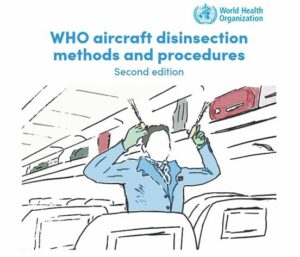CHANGES IN AIRCRAFT DISINSECTION
11 January 2024

World Health Organisation (WHO) have recently released the 2nd edition of the “WHO aircraft disinsection methods and procedures”
This document, released on November 23rd, 2023, replaces WHO’s previous formal publications on aircraft disinsection and describes the latest updated methods and procedures for disinsection of internal areas of passenger, military and cargo aircrafts.
⚠️ Especially, don’t miss out the changes in the recommended doses for the aerosol disinsection treatment of:
_ forward and aft holds of commercial passenger aircrafts,
_ main deck cargo area of freighter aircrafts,
_ forward and aft holds of freighter aircrafts.
ℹ️ Aircraft disinsection is a procedure whereby health measures are taken to control or kill insects present in aircraft, baggage, cargo, containers, goods and post. This is a requirement in order to meet the International Health Regulations (2005) (IHR) to control insect vectors of human diseases.
Intended for use by Member States and stakeholders (ie. airlines, airport authorities, members of the ICAO, pesticide manufacturers and pesticide regulatory agencies), the “WHO aircraft disinsection methods and procedures” recommandations and guideles provides updates on insecticide application methods and equipment, physical requirements of aerosol and residual sprays, and revised calculation tables for aerosol spray amounts required, as well as updated examples of pre-embarkation and pre-departure cabin treatment and certification requirements of the International Civil Aviation Organization (ICAO).
WHO recommends that national authorities implement measures requiring airlines to adhere to the revised procedures for aircraft disinsection from no later than 3 months after the date of online publication of this document by WHO.
Link to official World Health Organisation document:
https://iris.who.int/bitstream/handle/10665/374318/9789240080317-eng.pdf?sequence=1
👋 With 30, 40, 60 and 100g formats and single-shot & muti-shot actuators, PSA range of compliant Non Flammable Aircraft Approved Insecticide aerosols is currently the largest available range to comply with the WHO recommendations, address all aircraft configurations, optimize the release of biocide, and reduce the wastage, while facilitating the spraying operation.
More details:
https://psa-paris.com/fr/3-1-aircraft-approved-biosecurity-insecticides/









